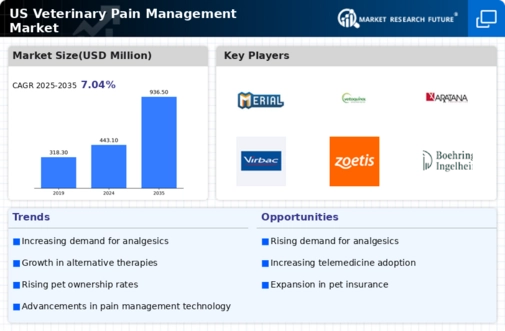Rising Pet Ownership Rates
The veterinary pain-management market experiences growth due to increasing pet ownership rates in the US. As more households adopt pets, the demand for veterinary services, including pain management, escalates. According to recent statistics, approximately 67% of US households own a pet, which translates to around 85 million families. This surge in pet ownership correlates with a heightened awareness of animal health and well-being, prompting owners to seek effective pain management solutions for their pets. Consequently, veterinary practices are expanding their offerings to include advanced pain management therapies, thereby driving market growth. The increasing willingness of pet owners to invest in their pets' health further supports the expansion of the veterinary pain-management market, as they prioritize quality of life and pain relief for their animals.
Increased Awareness of Chronic Pain in Animals
There is a growing recognition of chronic pain in animals, which significantly impacts the veterinary pain-management market. Pet owners and veterinarians alike are becoming more aware of the long-term effects of untreated pain, leading to a shift in treatment approaches. Studies indicate that chronic pain affects a substantial portion of the pet population, particularly in older animals. This awareness drives demand for effective pain management solutions, as owners seek to improve their pets' quality of life. Consequently, veterinary practices are increasingly adopting comprehensive pain management protocols, including multimodal therapies that address various pain mechanisms. This trend not only enhances the welfare of animals but also propels the veterinary pain-management market forward.
Regulatory Support for Pain Management Products
Regulatory bodies in the US are increasingly supporting the development and approval of pain management products for animals, which positively influences the veterinary pain-management market. The approval of new analgesics and anti-inflammatory medications provides veterinarians with a broader range of treatment options. Additionally, regulatory initiatives aimed at ensuring the safety and efficacy of these products foster confidence among veterinary professionals and pet owners. As a result, the market is likely to witness an influx of innovative pain management solutions, enhancing the overall treatment landscape. This regulatory support not only facilitates the introduction of new products but also encourages research and development in the field, further driving the growth of the veterinary pain-management market.
Growing Demand for Preventive Healthcare in Pets
The veterinary pain-management market is also influenced by the increasing demand for preventive healthcare among pets. Pet owners are becoming more proactive in seeking veterinary care to prevent pain and related health issues. This trend is reflected in the rising popularity of wellness programs and regular health check-ups, which often include pain assessments. By identifying potential pain issues early, veterinarians can implement preventive measures, thereby improving the overall health and well-being of pets. This proactive approach not only enhances the quality of life for animals but also drives the demand for pain management solutions. As preventive healthcare continues to gain traction, the veterinary pain-management market is expected to expand, offering a range of services and products tailored to meet the needs of pet owners.
Technological Innovations in Veterinary Medicine
Technological advancements play a pivotal role in shaping the veterinary pain-management market. Innovations such as telemedicine, wearable health monitoring devices, and advanced imaging techniques enhance the ability of veterinarians to diagnose and manage pain effectively. For instance, the integration of telemedicine allows for remote consultations, enabling pet owners to access pain management advice without the need for in-person visits. Furthermore, the development of sophisticated imaging technologies aids in the accurate assessment of pain-related conditions, leading to more targeted treatment plans. As these technologies become more prevalent, they are likely to improve the overall efficiency and effectiveness of pain management strategies in veterinary practices, thereby contributing to the growth of the veterinary pain-management market.



















Leave a Comment